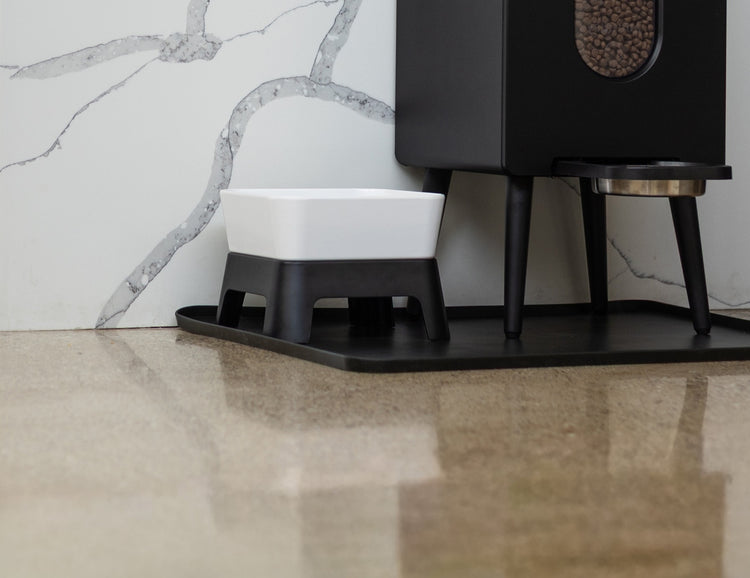What Can I Feed My Overweight Dog to Lose Weight? A Comprehensive Guide
- Houndsy
Table of Contents
- Introduction
- Understanding Canine Obesity
- What Can I Feed My Overweight Dog?
- Encouraging Exercise for Weight Loss
- Monitoring Progress
- Conclusion
- FAQ
Introduction
Did you know that nearly 60% of dogs in the United States are classified as overweight or obese? This staggering statistic highlights a growing epidemic that not only affects a dog's quality of life but can also shorten their lifespan. As devoted dog owners, we want our furry friends to thrive, and helping them achieve a healthy weight is one of the best gifts we can give them.
In this blog post, we will explore the essential dietary strategies and feeding practices that can help your overweight dog shed those extra pounds safely and effectively. By the end of this article, you'll have a clear understanding of what you can feed your overweight dog to lose weight and how to implement a successful weight management plan.
We will cover a range of topics, including the importance of portion control, understanding the right types of food, and the role of exercise in weight loss. Additionally, we'll discuss how to monitor your dog's progress and ensure their nutritional needs are met throughout their weight loss journey. So whether you're seeking to make small adjustments or embark on a complete dietary overhaul, we're here to support you every step of the way!
Understanding Canine Obesity
The Causes of Canine Obesity
Before we delve into the specifics of feeding practices, it's crucial to understand the underlying causes of canine obesity. Excess weight in dogs can stem from a variety of factors, including:
- Overfeeding: Many pet owners inadvertently provide too many calories, especially with treats.
- Lack of Exercise: A sedentary lifestyle can contribute significantly to weight gain. Dogs, like humans, need regular physical activity to maintain a healthy weight.
- Medical Conditions: Some health issues, such as hypothyroidism or Cushing's disease, can lead to weight gain. Always consult with your veterinarian if you suspect an underlying medical condition.
- Age and Breed: Older dogs may have slower metabolisms, and certain breeds are predisposed to obesity.
Understanding these factors can help us identify the best strategies for addressing your dog's weight issues.
The Health Risks of Obesity
The health risks associated with canine obesity are serious and can lead to a variety of complications, including:
- Diabetes
- Joint Problems: Excess weight puts additional strain on joints, leading to arthritis and mobility issues.
- Heart Disease
- Respiratory Issues
- Shortened Lifespan: Studies show that dogs with a healthy weight can live up to two years longer than their overweight counterparts.
Recognizing the importance of addressing these risks can motivate us to take action for our dog's health.
What Can I Feed My Overweight Dog?
Choosing the Right Dog Food
When it comes to helping your dog lose weight, the type of food you choose is critical. Here are some important considerations:
- Weight Management Dog Food: Look for veterinarian-recommended weight management diets that are lower in calories but higher in fiber. These specialized foods help your dog feel full while reducing caloric intake.
- High-Quality Ingredients: Choose dog food made with high-quality proteins, whole grains, and healthy fats. Avoid foods with fillers like corn and soy, which offer little nutritional value.
- Real Food Options: Fresh, whole-food diets can be beneficial. These diets typically contain fewer fillers and preservatives and provide better nutrient absorption. For instance, meals that include lean meats and vegetables can contribute to a healthier weight loss journey.
- Canned vs. Dry Food: Canned food often contains higher moisture content, which can help with hydration and satiety. This can be particularly useful for dogs that need to lose weight.
Portion Control
Portion control is a fundamental aspect of any weight loss plan. Here’s how to effectively manage your dog’s portions:
- Calculate Caloric Needs: Work with your veterinarian to establish how many calories your dog should consume daily to lose weight. A general guideline is that dogs should lose 1-2% of their body weight per week.
- Measure Food Accurately: Use a kitchen scale to measure your dog's food in grams rather than using cups, which can lead to inaccuracies. This helps ensure your dog receives the precise amount needed for weight loss.
- Scheduled Feeding Times: Instead of free-feeding, establish a feeding schedule where your dog receives meals at specific times. This helps prevent overeating and encourages a healthy routine.
Healthy Treat Alternatives
Treats can often derail a weight loss plan, but they don’t have to. Here are some healthier alternatives:
- Vegetable Snacks: Many dogs enjoy crunchy vegetables such as carrots, green beans, and cucumbers. These low-calorie snacks can satisfy your dog’s need to munch without adding extra weight.
- Fruits: Fruits like apples (without seeds) and blueberries can be excellent treats in moderation. Just be cautious with the quantity, as fruits can contain sugar.
- Homemade Treats: Consider making homemade dog treats using whole ingredients like pumpkin or sweet potatoes to ensure they are healthy and low in calories.
Keeping Track of Treats
While treats can be a part of your dog’s diet, it’s essential to consider their caloric contribution. A good rule of thumb is that treats should not exceed 10% of your dog’s total daily caloric intake. Keep a log of treats given daily to avoid overindulgence.
Encouraging Exercise for Weight Loss
The Importance of Physical Activity
Exercise is a crucial component of any weight loss plan for dogs. Not only does it help burn calories, but it also improves muscle tone and overall health. Here are some tips to encourage your dog to be more active:
- Daily Walks: Aim for at least 30 minutes of brisk walking each day. If your dog is not currently active, start with shorter walks and gradually increase the duration and intensity.
- Interactive Play: Engage your dog in playtime with fetch, tug-of-war, or using puzzle toys that encourage movement and mental stimulation.
- Swimming: If your dog enjoys water, swimming can be an excellent low-impact exercise option that is easy on the joints.
- Family Involvement: Involve the entire family in your dog's exercise routine. Making it a group activity can create a fun and supportive environment for your dog’s fitness journey.
Setting Realistic Goals
Setting achievable, incremental goals can help keep you and your dog motivated. Rather than focusing solely on the end weight goal, celebrate small victories along the way, such as completing a new walking route or successfully incorporating healthy treats into your dog's diet.
Monitoring Progress
Regular Weigh-Ins
Regularly monitor your dog’s weight to assess the effectiveness of the weight loss plan. Aim to weigh your dog every 1-2 weeks and track the results. If there’s no weight loss over a couple of weeks, consider adjusting the caloric intake or consult your veterinarian for advice.
Health Check-Ups
Work closely with your veterinarian to ensure that your dog is on a safe weight loss journey. They can provide valuable insights and help rule out any underlying health issues that may be affecting your dog’s weight loss.
Conclusion
Helping your overweight dog lose weight is a commitment that can significantly enhance their quality of life and extend their longevity. By understanding the right types of food, implementing portion control, encouraging exercise, and monitoring their progress, we can pave the way for a healthier, happier dog.
As we embark on this journey together, remember that each dog is unique, and what works for one may not work for another. Tailor your approach to fit your dog’s needs, and don’t hesitate to consult with your veterinarian for personalized guidance.
If you're looking for innovative solutions to enhance your dog's feeding experience, consider exploring the Houndsy Kibble Dispenser. Our dispenser not only ensures perfect portion control but also complements your home decor with its sleek, modern design. Let’s elevate your dog’s feeding routine while supporting their weight loss journey!
FAQ
1. How much should I feed my overweight dog?
Consult your veterinarian to determine the appropriate daily caloric intake based on your dog's ideal weight and activity level. Measure food accurately to ensure portion control.
2. Can I still give my dog treats while they are on a weight loss plan?
Yes, but treats should be limited to 10% of your dog's daily caloric intake. Opt for low-calorie, healthy alternatives like vegetables or fruits.
3. How quickly should my dog lose weight?
A safe weight loss target is 1-2% of your dog's body weight per week. Rapid weight loss can be harmful and should be avoided.
4. What are some signs that my dog is overweight?
Signs include difficulty breathing, lack of energy, difficulty walking, and an inability to feel their ribs when you touch their sides.
5. Should I consult my vet before starting a weight loss plan?
Absolutely! Your veterinarian can help rule out any medical issues, provide tailored nutritional advice, and monitor your dog's progress.











